
- Type:
- artificial reef, buoy tender
- Built:
- 1969
- Specs:
- ( 46' x 16' )
- Sponsor:
- USCG, New Jersey State Police
- Sunk:
- Thursday September 9, 1993 - Cape May Artificial Reef
- GPS:
- 38°51.106' -74°42.170'
More: Johnny Buoy BUSL ...
The pink and white areas are shipping lanes. 'Natural' shipwrecks are depicted with a wreck symbol.
More: Artificial Reefs ...

More: Johnny Buoy BUSL ...

More: Kathy & Maria ...

More: Kiley B ...

More: King's Point ...

More: Lady Dee ...

More: Laita ...

More: Lewis F Boyer ...

More: Libra ...

More: Lieutenant ...

More: Lisa Kim ...